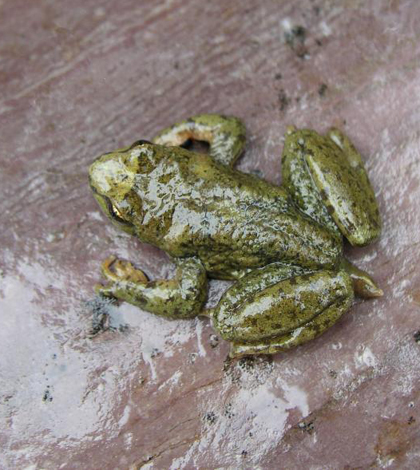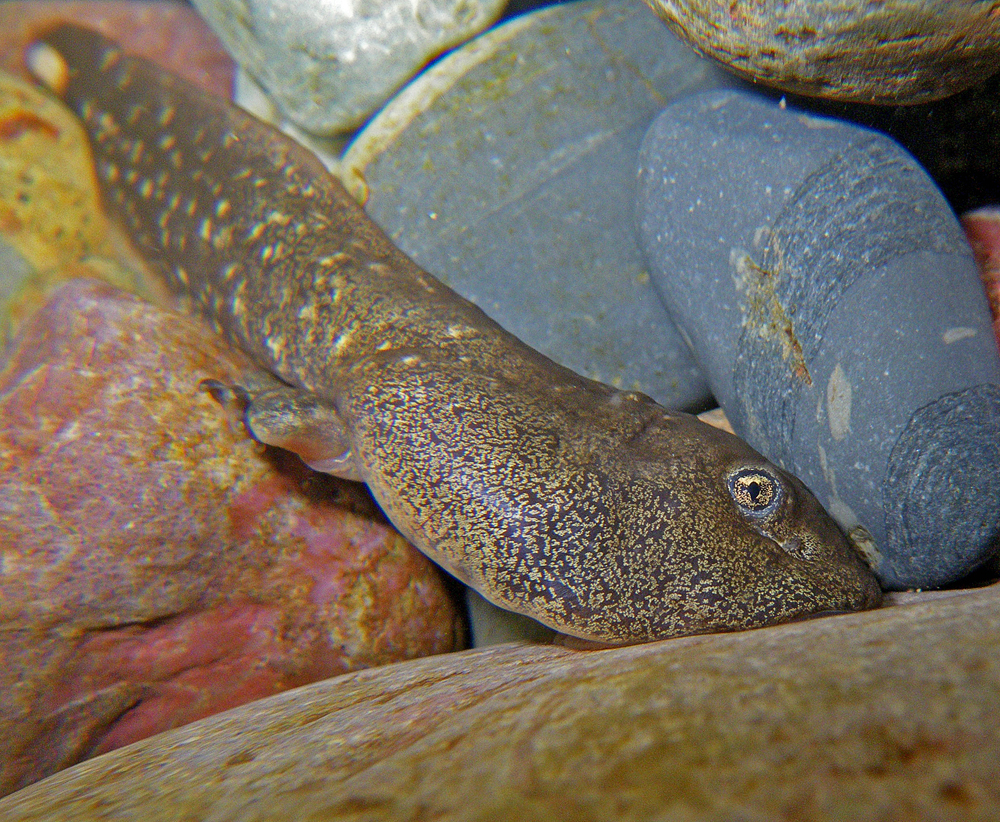Study boosts Rocky Mountain tailed frogs’ odds against climate change

Adult male Rocky Mountain tailed frog (Credit: Stephen Corn/USGS)
The warming effects of climate change will likely be toughest on species that depend on steady temperatures and would have a hard time leaving their preferred habitats once things get uncomfortable. Rocky Mountain tailed frogs from the consistently cold streams of their namesake range are a good example.
It’s often up to biologists to project the effects of climate change on the numbers and geographic distribution of a species like tailed frogs. But that job is made more complicated by the fact that not every population of a species will necessarily react to rising temperatures in the same way.
“If you’ve got some populations that have more ability to acclimate to changing temperatures, they’ll do better under a warming regime than populations that have no capacity to adapt,” said Blake Hossack, a U.S. Geological Survey research zoologist based in Missoula, Mont.
That appears to be the case with Rocky Mountain tailed frogs, according to research lead by Hossack that was recently published in the journal Freshwater Biology. A laboratory study of tailed frog tadpoles collected from small streams across Glacier National Park showed that animals from some streams were more likely to survive warmer temperatures than those from others.
The park was an ideal place to collect tadpoles because it features a wide variety of habitats and climates, Hossack said. On the western edge is North America’s farthest-inland temperate rain forest, yet the eastern edge is dry enough to mark the beginning of the Great Plains.
The diversity of habitat types meant that the researchers could pick study streams within the park that represented several different levels of temperature variability, or the amount that water temperatures changed on a daily basis. In each stream where tadpoles were collected, the researchers installed HOBO temperature loggers in each stream that recorded water temperatures hourly for around a month over August and September. That data showed that some streams stayed at a relatively consistent temperature, while others experienced daily swings as great as 5 degrees Celsius.
Back in the lab, the researchers divided up the tadpoles into tanks, where they were fed a specially formulated diet that consisted of ingredients including ground rice hulls and spirulina algae. In most tailed frog lab experiments, the tadpoles use their sucker-like mouths to feed on algae-covered rocks that researchers bring in from nearby streams. But this experiment was conducted in the Bozeman Fish Technology Center, a U.S. Fish and Wildlife Service facility that also raises endangered fish like the pallid sturgeon. To protect those species, the lab has strict rules about what can be brought into the lab to prevent the introduction of diseases.
“They’ve got a guy there whose specialty is actually formulating diets for these fish, and he took up the tadpole challenge,” Hossack said. “Species like leopard frog or bull frog tadpoles, you can just throw in boiled cabbage or boiled lettuce and they’ll eat that. But these guys are so specialized, they won’t eat that food and they won’t eat any other commercial products that we tried.”

A 3-year-old Rocky Mountain tailed frog tadpole latched onto a rock (Credit: Joe Giersch/USGS)
Once the tadpoles were acclimated to their tanks, the researchers slowly raised the water temperatures, exposing a few from each stream to 10-, 14-, 18- or 22-degree C water. After 79 days of data collection, a clear pattern emerged. The tadpoles that came from the streams with the greatest temperature variability were more likely to survive exposure to the warmest temperatures. “Just the exposure to variation in the field seemed to provide the ability to withstand higher mean temperatures,” Hossack said.
The results make since, given that exothermic species like frogs that have been shown to be most sensitive to temperature swings tend to be those from tropical areas or cold aquatic environments, Hossack said. Even though animals in the tropics, for example, are used to warm temperatures, they expect them to stay that way.
“Those animals did not evolve with variation, so they actually have very little capacity to cope with it,” Hossack said. “We see the same thing in these species that are specialized to cold temperatures like tailed frogs.”
It’s difficult to know whether the ability to survive warmer temperatures for some Rocky Mountain tailed frogs is an effect of genetic variability between stream populations, an effect of growing up in streams with temperature swings, or some combination of the two. Either way, if one segment of the species is able to hold out against the warming temperatures that scientists predict, it could be a boon for the species’ chances to adapt to climate change.
“I’m certainly not going to say it’s going to offset it and we don’t have to worry about anything. But it could at least slow the rate of decline compared to some of the projections,” Hossack said. “It offers a glimmer of hope. I try to be an optimist sometimes. It’s not always easy when you’re a conservation biologist.”
Top image: Adult male Rocky Mountain tailed frog (Credit: Stephen Corn/USGS)




0 comments